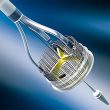Next-day discharge after transfemoral transcatheter aortic valve replacement (TAVR) might be viable, with no major complications at 30 days or one year, compared against patients with longer hospital stay. We only have to consider a few factors that will help us choose the most adequate patients for this modality without compromising safety. One of the main advantages<a href="https://solaci.org/en/2018/03/19/next-day-discharge-after-tavr-is-it-viable/" title="Read more" >...</a>
Red Light for TAVR in Low Surgical Risk Patients
A new study raises an alarm against expanding transcatheter aortic valve replacement (TAVR) procedures to low surgical risk patients, since 2 year mortality seems higher in these patients with TAVR, compared to conventional surgery. This study will soon be published in Catheter Cardiovasc Interv. Expanding TAVR to low risk patients might involve risks we have not<a href="https://solaci.org/en/2018/03/14/red-light-for-tavr-in-low-surgical-risk-patients/" title="Read more" >...</a>
Coronary Disease Works as a 30-Day Predictor in TAVR
The association between aortic stenosis and coronary disease is common, since both conditions share pathogenesis, risk factors, and symptoms. Transcatheter aortic valve replacement (TAVR) is currently indicated for high-risk and inoperable patients. It also appears as a valid alternative for the treatment of intermediate-risk patients, and it could soon be indicated for low-risk patients. Coronary<a href="https://solaci.org/en/2018/02/20/coronary-disease-works-as-a-30-day-predictor-in-tavr/" title="Read more" >...</a>
Who Lives Longer After TAVR, Men or Women?
Courtesy of Dr. Carlos Fava. Currently, some small observational studies and a meta-analysis suggest that women experience more short-term complications after TAVR (due to higher rates of bleeding, vascular complications, and stroke), as well as less 1-year mortality. However, results are still conflicting. This work analyzed 17 studies including 8 different registries, with a total 23,303 women and 23,885 men.<a href="https://solaci.org/en/2018/02/14/who-lives-longer-after-tavr-men-or-women/" title="Read more" >...</a>
WIN TAVI: The Largest Female TAVR Registry So Far
Courtesy of Dr. Carlos Fava. In most randomized or observational studies, women comprise more than 50% of patients undergoing TAVR, and they have showed better evolution, compared against surgery. The main differences between men and women with severe aortic stenosis are that women have smaller annular dimension, shorter distance to coronary ostia, smaller peripheral arteries, and<a href="https://solaci.org/en/2018/01/24/win-tavi-the-largest-female-tavr-registry-so-far/" title="Read more" >...</a>
The Perks of Conscious Sedation in TAVR
The main advantage of transcatheter aortic valve replacement (TAVR) has always been its less invasive nature, compared against surgery. Many of the advances in this technique revolve around making it even less invasive, increasing the gap between the two. The kind of anesthesia has been one of these many advances. There are several reports (in general from<a href="https://solaci.org/en/2018/01/05/the-perks-of-conscious-sedation-in-tavr/" title="Read more" >...</a>
Cardiac Damage: Should we start to assess it?
Courtesy of Dr. Carlos Fava. The current recommendation for aortic valve replacement is based on stenosis severity based on valvular criteria (mean transvalvular gradient, peak aortic velocity and valve index area) and the presence of symptoms, in addition to comorbidities, mainly for risk stratification. However, ventricular damage and/or its effect on cardiovascular hemodynamics are not regarded<a href="https://solaci.org/en/2017/12/20/cardiac-damage-should-we-start-to-assess-it/" title="Read more" >...</a>
Peripheral Vascular Disease Is Associated to More Events in TAVR
Courtesy of Dr. Carlos Fava. The incidence of peripheral vascular disease (PVD) is increasing and associated with negative outcomes when overlapping with cardiovascular disease. In patients undergoing TAVR, its prevalence varies between 28% and 42%, according to different studies. However, its real impact on the rate of survival is still unclear. This study analyzed 27,440 patients >65 years<a href="https://solaci.org/en/2017/12/11/peripheral-vascular-disease-is-associated-to-more-events-in-tavr/" title="Read more" >...</a>
New Study Confirms TAVR Durability at 5 Years
The ADVANCE study was designed to evaluate the safety and effectiveness of transcatheter aortic valve replacement (TAVR) with self-expanding prosthesis CoreValve in “real world” patients with symptomatic, severe aortic stenosis at high surgical risk. Patients were enrolled from 44 experimental centers in 12 countries; treatment approach and choice of anaesthesia were determined by the local Heart Team.<a href="https://solaci.org/en/2017/10/25/new-study-confirms-tavr-durability-at-5-years/" title="Read more" >...</a>
REPRISE III: Need for Pacemaker and Paravalvular Leak with Lotus
A recent presentation at London Valves took a closer look at the REPRISE III trial as regards two points that generated much discussion, such as need for a pacemaker and paravalvular leak. REPRISE III had previously demonstrated that the Lotus is noninferior to first-generation CoreValve and Evolut R in terms of safety. Additionally, it proved to be superior<a href="https://solaci.org/en/2017/10/18/reprise-iii-need-for-pacemaker-and-paravalvular-leak-with-lotus/" title="Read more" >...</a>









